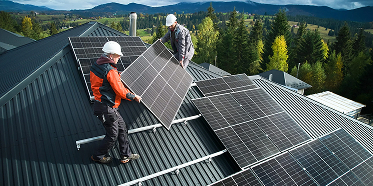About Us
Incorporated in the year B.S. 2081, Mountain Solar Holdings Pvt. Ltd. has successfully received the largest number of Letter of Intent (LoI) from the Nepal Electricity Authority to develop 230 MW of grid-connected solar power plants across 17 locations in Western Nepal. Each project will be interconnected to the Nepal Electricity Authority’s substations via 33 kV power evacuation lines, with grid substation interconnection voltages at 132 kV and DCS substation connections at 33 kV. On average, each project is expected to generate approximately 19,000 MWh of clean energy annually.
Current Status
- Nepal has over 100 MW of installed solar capacity, with hundreds of MW in the pipeline, including major projects like those led by Mountain Solar Holdings and other IPPs.
- Solar energy is now recognized not only as a tool for rural development but also as a key contributor to national energy security, climate goals, and energy diversification.
Why Solar is Important for Nepal
While hydropower remains Nepal’s energy backbone, but its variability and vulnerability underscore the critical need for solar integration. Together, hydro and solar form a complementary, resilient, and sustainable energy mix, enabling Nepal to meet growing demand, reduce import dependence, and transition toward a low-carbon future.
The Significance and Intricate Role of Solar Energy Alongside Hydropower in Nepal
Nepal’s energy sector has long been dominated by hydropower, thanks to its abundant river systems and mountainous terrain. However, as the country pursues energy security, reliability, and sustainability, solar energy is emerging as a strategic complement to hydropower—not as a substitute, but as an essential partner.
-
Seasonal Complementarity
- Nepal’s hydropower generation is highly seasonal, peaking during the monsoon months (June–September) when rivers swell, and dropping sharply in the dry season (December–April).
- In contrast, solar energy production is highest during dry, sunny months, precisely when hydropower output declines.
- This natural complementarity between hydro and solar helps stabilize electricity supply year-round, reducing the need for expensive imports or fossil-fuel backups.
-
Enhancing Grid Reliability and Energy Security
- During dry seasons or drought years, Nepal often faces energy deficits. Integrating utility-scale solar reduces reliance on imported electricity and ensures domestic supply resilience.
- Distributed solar (e.g., rooftop or mini-grid systems) can serve remote areas not yet connected to the national grid, reducing pressure on hydropower and transmission systems.
-
Diversification of Energy Mix
- Overdependence on a single source like hydropower only poses risks related to climate variability, natural disasters, and grid fragility.
- A diversified mix with solar and hydro ensures greater energy security, especially as demand rises with urbanization, electrification of transport, and industrial growth.
-
Faster Deployment and Investment Efficiency
- Hydropower projects require long lead times, heavy civil construction, complex environmental clearances, and large capital outlays.
- In contrast, solar projects are quicker to deploy, modular, and require less land and permitting complexity.
- This makes solar ideal for bridging short- to medium-term gaps, complementing hydro’s long-term base load generation.
-
Enabling Energy Access and Decentralization
- Solar plays a crucial role in decentralized energy systems, providing power to remote and off-grid communities where hydro is unfeasible.
- Mini-grid and standalone solar systems are key to inclusive electrification, supporting agriculture, education, and healthcare in rural Nepal.
-
Supporting Climate Commitments
- Nepal’s Nationally Determined Contributions (NDCs) emphasize increased renewable energy deployment to meet net-zero goals.
- A balanced hydro-solar strategy helps reduce carbon emissions, enhances climate resilience, and aligns with green development goals.


